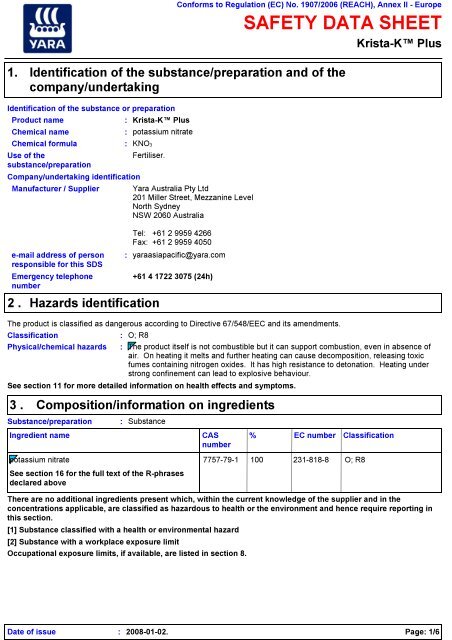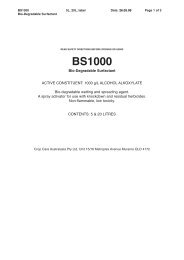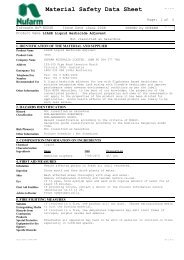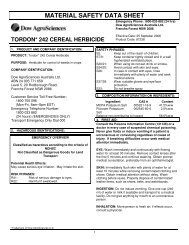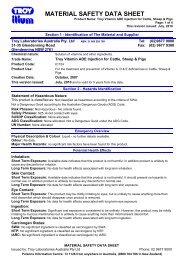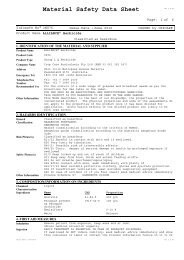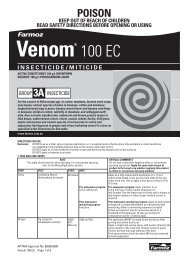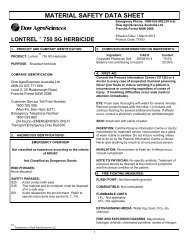msds_krista_k_plus - Agsure
msds_krista_k_plus - Agsure
msds_krista_k_plus - Agsure
Create successful ePaper yourself
Turn your PDF publications into a flip-book with our unique Google optimized e-Paper software.
Conforms to Regulation (EC) No. 1907/2006 (REACH), Annex II - Europe<br />
SAFETY DATA SHEET<br />
Krista-K Plus<br />
1.<br />
Identification of the substance/preparation and of the<br />
company/undertaking<br />
Identification of the substance or preparation<br />
Product name<br />
: Krista-K Plus<br />
Chemical name<br />
: potassium nitrate<br />
Chemical formula<br />
: KNO3<br />
Use of the<br />
Fertiliser.<br />
substance/preparation<br />
Company/undertaking identification<br />
Manufacturer / Supplier<br />
e-mail address of person<br />
responsible for this SDS<br />
Emergency telephone<br />
number<br />
2 .<br />
Hazards identification<br />
Yara Australia Pty Ltd<br />
201 Miller Street, Mezzanine Level<br />
North Sydney<br />
NSW 2060 Australia<br />
Tel: +61 2 9959 4266<br />
Fax: +61 2 9959 4050<br />
: yaraasiapacific@yara.com<br />
+61 4 1722 3075 (24h)<br />
The product is classified as dangerous according to Directive 67/548/EEC and its amendments.<br />
Classification<br />
: O; R8<br />
Physical/chemical hazards : The product itself is not combustible but it can support combustion, even in absence of<br />
air. On heating it melts and further heating can cause decomposition, releasing toxic<br />
fumes containing nitrogen oxides. It has high resistance to detonation. Heating under<br />
strong confinement can lead to explosive behaviour.<br />
See section 11 for more detailed information on health effects and symptoms.<br />
3 .<br />
Composition/information on ingredients<br />
Substance/preparation<br />
Ingredient name<br />
:<br />
Substance<br />
CAS<br />
number<br />
% EC number Classification<br />
potassium nitrate 7757-79-1 100 231-818-8 O; R8<br />
See section 16 for the full text of the R-phrases<br />
declared above<br />
There are no additional ingredients present which, within the current knowledge of the supplier and in the<br />
concentrations applicable, are classified as hazardous to health or the environment and hence require reporting in<br />
this section.<br />
[1] Substance classified with a health or environmental hazard<br />
[2] Substance with a workplace exposure limit<br />
Occupational exposure limits, if available, are listed in section 8.<br />
Date of issue : 2008-01-02. Page: 1/6
Krista-K Plus<br />
4.<br />
First-aid measures<br />
Inhalation<br />
: Avoid breathing dust. If inhaled, remove to fresh air.<br />
Ingestion<br />
: If large quantities of this material are swallowed, call a physician immediately. Do not<br />
induce vomiting unless directed to do so by medical personnel. Never give anything by<br />
mouth to an unconscious person.<br />
Skin Contact<br />
: Avoid prolonged or repeated contact with skin. After handling, always wash hands<br />
thoroughly with soap and water. Get medical attention if irritation develops.<br />
Eye contact<br />
: In case of contact with eyes, rinse immediately with plenty of water. Get medical<br />
attention if irritation occurs.<br />
Protection of first-aiders : No action shall be taken involving any personal risk or without suitable training. It may<br />
be dangerous to the person providing aid to give mouth-to-mouth resuscitation.<br />
See section 11 for more detailed information on health effects and symptoms.<br />
5.<br />
Fire-fighting measures<br />
Extinguishing media :<br />
Hazardous thermal<br />
decomposition products<br />
Special protective equipment<br />
for fire-fighters<br />
Remark<br />
6. Accidental release measures<br />
Personal precautions<br />
Environmental precautions<br />
and clean-up methods<br />
:<br />
Use water only in flooding quantities. Do not release runoff from fire to sewers or<br />
waterways.<br />
Avoid breathing dusts, vapours or fumes from burning materials. In case of inhalation of<br />
decomposition products in a fire, symptoms may be delayed.<br />
These products are: nitrogen oxides (NO, NO2 etc.)<br />
: Fire-fighters should wear appropriate protective equipment and self-contained breathing<br />
apparatus (SCBA) with a full face-piece operated in positive pressure mode.<br />
The product itself is not combustible but it can support combustion, even in absence of<br />
air. On heating it melts and further heating can cause decomposition, releasing toxic<br />
fumes containing nitrogen oxides. It has high resistance to detonation. Heating under<br />
strong confinement can lead to explosive behaviour.<br />
: Immediately contact emergency personnel. Eliminate all ignition sources. Keep<br />
unnecessary personnel away. Use suitable protective equipment (section 8). Follow all<br />
fire-fighting procedures (section 5). Do not touch or walk through spilt material.<br />
: Avoid contact of spilt material and runoff with soil and surface waterways.<br />
:<br />
Use a tool to scoop up solid material and place into an appropriate labelled waste<br />
container. Do not mix with sawdust or other combustible material. Avoid creating dusty<br />
conditions and prevent wind dispersal. Keep out of waterways. See section 13 for waste<br />
disposal information.<br />
Note: see section 8 for personal protective equipment and section 13 for waste disposal.<br />
7.<br />
Handling and storage<br />
Handling<br />
Storage<br />
Packaging materials<br />
Recommended<br />
:<br />
:<br />
Avoid the creation of dust when handling and avoid all possible sources of ignition (spark<br />
or flame). Avoid contamination by any source including metals, dust and organic<br />
materials. Prevent moisture pick-up in handling and storage.<br />
Keep container tightly closed. Keep container in a cool, well-ventilated area. Separate<br />
from acids, alkalis, reducing agents and combustibles. On farm keep away from hay,<br />
grain, diesel, etc.<br />
: Use original container.<br />
Date of issue : 2008-01-02. Page: 2/6
Krista-K Plus<br />
8. Exposure controls/personal protection<br />
Occupational exposure<br />
limits<br />
Exposure controls<br />
Respiratory protection :<br />
Hand protection<br />
Eye protection :<br />
Skin protection<br />
:<br />
:<br />
:<br />
Total inhalable dust - 10 mg/m 3<br />
Respirable dust - 5 mg/m 3<br />
Recommended: If ventilation is inadequate, use respirator that will protect against<br />
dust/mist. Filter P2 (EN 143)<br />
Chemical-resistant, impervious gloves complying with an approved standard should be<br />
worn at all times when handling chemical products if a risk assessment indicates this is<br />
necessary.<br />
>8 hours (breakthrough time): butyl rubber, neoprene.<br />
Recommended: Use dust goggles if high dust concentration is generated.<br />
Personal protective equipment for the body should be selected based on the task being<br />
performed and the risks involved.<br />
Wash hands, forearms and face thoroughly after handling chemical products, before<br />
eating, smoking and using the lavatory and at the end of the working period.<br />
9.<br />
Physical and chemical properties<br />
General information<br />
Appearance<br />
Physical state<br />
: Solid.<br />
Colour<br />
: White.<br />
Odour<br />
: Odourless.<br />
Important health, safety and environmental information<br />
pH<br />
: 6 to 9 [Conc. (% w/w): 10%]<br />
Boiling point<br />
: Decomposition temperature: 400°C (752°F)<br />
Melting/freezing point : 334°C (633,2°F)<br />
Density (g/cm 3 )<br />
: 0,89 to 1,1 g/cm 3<br />
Solubility<br />
: Soluble in the following materials: cold water<br />
Solubility (at 20°C)<br />
: 316 g/l<br />
10.<br />
Stability and reactivity<br />
Stability<br />
Conditions to avoid<br />
Materials to avoid :<br />
Hazardous decomposition<br />
products<br />
:<br />
:<br />
:<br />
Stable under recommended storage and handling conditions (see section 7).<br />
The resistance to detonation is decreased by a number of factors such as the presence<br />
of contaminants and/or high temperature. Heating under strong confinement (e.g. in<br />
tubes or drains) may lead to a violent reaction or explosion.<br />
Contamination by substances such as carbonaceous materials, chromates, zinc, copper<br />
and their alloys, chlorates, alkalies and reducing agents decrease the resistance to<br />
detonation.<br />
These products are: nitrogen oxides (NO, NO2 etc.)<br />
11.<br />
Toxicological information<br />
Potential acute health effects<br />
May cause eye and skin irritation.<br />
Adverse health effects are considered unlikely, when the product is used according to directions.<br />
Product/ingredient name Result Species Dose References<br />
potassium nitrate LD50 Oral Rat 3750 mg/kg -<br />
LD50 Oral Rabbit 1901 mg/kg -<br />
Date of issue : 2008-01-02. Page: 3/6
11.<br />
Toxicological information<br />
Chronic effects : No known significant effects or critical hazards.<br />
Carcinogenicity : No known significant effects or critical hazards.<br />
Mutagenicity : No known significant effects or critical hazards.<br />
Teratogenicity : No known significant effects or critical hazards.<br />
Developmental effects : No known significant effects or critical hazards.<br />
Fertility effects<br />
: No known significant effects or critical hazards.<br />
Over-exposure signs/symptoms<br />
Inhalation<br />
Ingestion<br />
Skin<br />
Eyes<br />
12.<br />
:<br />
:<br />
No specific data.<br />
No specific data.<br />
: No specific data.<br />
: No specific data.<br />
Ecological information<br />
Environmental effects<br />
Aquatic ecotoxicity<br />
Other adverse effects<br />
: No known significant effects or critical hazards.<br />
Krista-K Plus<br />
Product/ingredient<br />
name<br />
Test Result<br />
Species Exposure References<br />
potassium nitrate Acute LC50 200 mg/L Fish 96 hours -<br />
Acute LC50 180 mg/L Fish 96 hours -<br />
Biodegradability<br />
Conclusion/Summary<br />
: No known significant effects or critical hazards.<br />
: The product does not show any bioaccumulation phenomena.<br />
13.<br />
Disposal considerations<br />
Methods of disposal<br />
European waste catalogue<br />
(EWC)<br />
Hazardous waste :<br />
Packaging waste<br />
14.<br />
International transport regulations<br />
Regulatory<br />
information<br />
Transport information<br />
:<br />
:<br />
Empty containers or liners may retain some product residues. Do not empty into drains;<br />
dispose of this material and its container in a safe way. Dispose of in accordance with all<br />
applicable local and national regulations<br />
06 03 14 solid salts and solutions other than those mentioned in 06 03 11 and 06 03 13<br />
This material and its container must be disposed of as hazardous waste.<br />
: Empty the bag by shaking to remove as much as possible of its contents. Empty bags may<br />
be disposed of as non-hazardous material or returned for recycling.<br />
UN number Proper shipping name Class Packing group Label Additional information<br />
ADR/RID Class<br />
UN1486<br />
POTASSIUM NITRATE 5.1 III<br />
Hazard identification number<br />
50<br />
5.1<br />
Limited quantity<br />
LQ12<br />
CEFIC Tremcard<br />
51S1486<br />
ADNR Class<br />
UN1486<br />
POTASSIUM NITRATE<br />
5.1<br />
III<br />
-<br />
5.1<br />
Date of issue : 2008-01-02. Page: 4/6
Krista-K Plus<br />
14. Transport information<br />
IMDG Class UN1486 POTASSIUM NITRATE 5.1 III<br />
Emergency schedules (EmS)<br />
F-A, S-Q<br />
5.1<br />
IATA-DGR Class<br />
UN1486<br />
POTASSIUM NITRATE<br />
5.1 III<br />
5.1<br />
Passenger and Cargo Aircraft<br />
Quantity limitation: 25 kg<br />
Cargo Aircraft OnlyQuantity<br />
limitation: 100 kg<br />
Limited Quantities -<br />
Passenger AircraftQuantity<br />
limitation: 10 kg<br />
The product in prilled form is not subject to the provisions for the transport of dangerous goods (as belonging to<br />
class 5.1), based on results of the test O.1 United Nations Manual of Tests and Criteria (ADR 2.2.51.1.5/IMDG<br />
chapter 3.3 provision 223).<br />
It is recommended to mention in the Transport documents "Product not belonging to Class 5,1" when the prilled<br />
product is transported as non dangerous (ADR 5.4.1.5).<br />
15.<br />
Regulatory information<br />
EU regulations<br />
Hazard symbol or<br />
symbols<br />
:<br />
Risk phrases :<br />
Safety phrases<br />
:<br />
Contains EINECS number :<br />
Product use<br />
:<br />
Oxidising<br />
R8- Contact with combustible material may cause fire.<br />
S17- Keep away from combustible material.<br />
S41- In case of fire and/or explosion do not breathe fumes.<br />
potassium nitrate 231-818-8<br />
Industrial applications.<br />
Europe inventory<br />
Classification and labelling have been performed according to EU Directives 67/548/EEC<br />
and 1999/45/EC (including amendments) and the intended use.<br />
: Europe inventory: This material is listed or exempted.<br />
16.<br />
Other information<br />
Full text of R-phrases<br />
referred to in sections 2 and<br />
3 - Europe<br />
Full text of classifications<br />
referred to in sections 2 and<br />
3 - Europe<br />
References<br />
History<br />
Date of printing<br />
Date of issue/Date of<br />
revision<br />
Version<br />
Prepared by<br />
:<br />
R8- Contact with combustible material may cause fire.<br />
: O - Oxidising<br />
2008-01-02.<br />
2008-01-02.<br />
Date of previous issue : 2005-09-05.<br />
: European Chemical Bureau, Annex 1 EU Directive 67/548/EEC<br />
National Institute for Occupational Safety and Health, U.S. Dept. of Health, Education,<br />
and Welfare, Reports and Memoranda<br />
Registry of Toxic Effects of Chemical Substances<br />
Atrion International Inc. 4777 Levy Street, St Laurent, Quebec HAR 2P9, Canada<br />
:<br />
:<br />
:<br />
:<br />
2<br />
Yara Product Classification and Regulations<br />
Date of issue : 2008-01-02. Page: 5/6
16.<br />
Other information<br />
Indicates information that has changed from previously issued version.<br />
Krista-K Plus<br />
Notice to reader<br />
To the best of our knowledge, the information provided in this Safety Data Sheet is accurate as at the date of its issue. The<br />
information it contains is being given for safety guidance purposes and relates only to the specific material and uses described in<br />
it. This information does not necessarily apply to that material when combined with other material(s) or when used otherwise<br />
than as described herein. Final determination of the suitability of any material is the sole responsibility of the user. All materials<br />
may represent unknown hazards and should be used with caution. Yara International ASA disclaims any liability for loss or<br />
damage resulting from the use of any data, information or recommendations set out in this Safety Data Sheet.<br />
Version 2<br />
Page: 6/6


